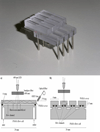Evanescent wave fluorescence biosensors: Advances of the last decade
- PMID: 26232145
- PMCID: PMC5012222
- DOI: 10.1016/j.bios.2015.07.040
Evanescent wave fluorescence biosensors: Advances of the last decade
Abstract
Biosensor development has been a highly dynamic field of research and has progressed rapidly over the past two decades. The advances have accompanied the breakthroughs in molecular biology, nanomaterial sciences, and most importantly computers and electronics. The subfield of evanescent wave fluorescence biosensors has also matured dramatically during this time. Fundamentally, this review builds on our earlier 2005 review. While a brief mention of seminal early work will be included, this current review will focus on new technological developments as well as technology commercialized in just the last decade. Evanescent wave biosensors have found a wide array applications ranging from clinical diagnostics to biodefense to food testing; advances in those applications and more are described herein.
Keywords: Applications; Evanescent wave; Fluorescence; Optical biosensor.
Copyright © 2015 Elsevier B.V. All rights reserved.
Figures





Similar articles
-
Optical biosensors.Essays Biochem. 2016 Jun 30;60(1):91-100. doi: 10.1042/EBC20150010. Essays Biochem. 2016. PMID: 27365039 Free PMC article. Review.
-
Amplification of the signal intensity of fluorescence-based fiber-optic biosensors using a Fabry-Perot resonator structure.Sensors (Basel). 2015 Feb 4;15(2):3565-74. doi: 10.3390/s150203565. Sensors (Basel). 2015. PMID: 25690548 Free PMC article.
-
Evanescent wave fluorescence biosensors.Biosens Bioelectron. 2005 Jun 15;20(12):2470-87. doi: 10.1016/j.bios.2004.10.026. Epub 2004 Dec 8. Biosens Bioelectron. 2005. PMID: 15854820 Review.
-
Optical biosensors based on refractometric sensing schemes: A review.Biosens Bioelectron. 2019 Nov 1;144:111693. doi: 10.1016/j.bios.2019.111693. Epub 2019 Sep 11. Biosens Bioelectron. 2019. PMID: 31539719 Review.
-
A double-taper optical fiber-based radiation wave other than evanescent wave in all-fiber immunofluorescence biosensor for quantitative detection of Escherichia coli O157:H7.PLoS One. 2014 May 7;9(5):e95429. doi: 10.1371/journal.pone.0095429. eCollection 2014. PLoS One. 2014. PMID: 24805354 Free PMC article.
Cited by
-
Evanescent Wave Optical-Fiber Aptasensor for Rapid Detection of Zearalenone in Corn with Unprecedented Sensitivity.Biosensors (Basel). 2022 Jun 22;12(7):438. doi: 10.3390/bios12070438. Biosensors (Basel). 2022. PMID: 35884240 Free PMC article.
-
Efficient Aerial Water Harvesting with Self-Sensing Dynamic Janus Crystals.J Am Chem Soc. 2024 Nov 6;146(44):30529-30538. doi: 10.1021/jacs.4c11689. Epub 2024 Oct 22. J Am Chem Soc. 2024. PMID: 39438244 Free PMC article.
-
Molecular Imprinted Polymers Coupled to Photonic Structures in Biosensors: The State of Art.Sensors (Basel). 2020 Sep 7;20(18):5069. doi: 10.3390/s20185069. Sensors (Basel). 2020. PMID: 32906637 Free PMC article. Review.
-
Plasmonic Modes and Fluorescence Enhancement Coupling Mechanism: A Case with a Nanostructured Grating.Nanomaterials (Basel). 2022 Dec 6;12(23):4339. doi: 10.3390/nano12234339. Nanomaterials (Basel). 2022. PMID: 36500962 Free PMC article.
-
Emerging Cytokine Biosensors with Optical Detection Modalities and Nanomaterial-Enabled Signal Enhancement.Sensors (Basel). 2017 Feb 22;17(2):428. doi: 10.3390/s17020428. Sensors (Basel). 2017. PMID: 28241443 Free PMC article. Review.
References
-
- Abdulhalim I. Small. 2014;10(17):3499–3514. - PubMed
-
- Agnarsson B, Halldorsson J, Arnfinnsdottir N, Ingthorsson S, Gudjonsson T, Leosson K. Microelectronic Eng. 2010;87(1):56–61.
-
- Albrecht C, Kaeppel N, Gauglitz G. Anal. Bioanal. Chem. 2008;391(5):1845–1852. - PubMed
-
- Anderson AS, Dattelbaum AM, Montaño GA, Price DN, Schmidt JG, Martinez JS, Grace WK, Grace KM, Swanson BI. Langmuir. 2008;24(5):2240–2247. - PubMed
-
- Anderson GP, Golden JP, Ligler FS. IEEE Trans. Biomed. Eng. 1994;41(6):578–584. - PubMed
Publication types
MeSH terms
Grants and funding
LinkOut - more resources
Full Text Sources
Other Literature Sources
Medical
Miscellaneous

